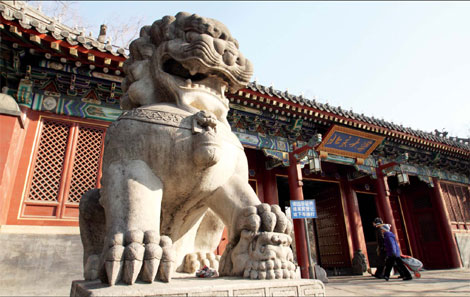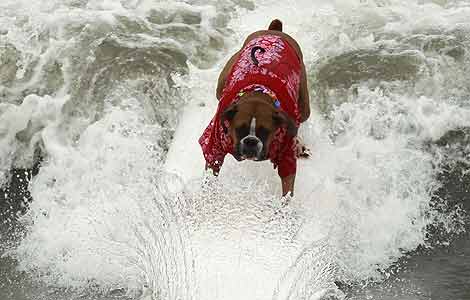Mane attraction
Updated: 2011-10-14 08:57
By Liu Xiaozhuo (China Daily)
|
|||||||||
|
The sculpture of a stone lion standing outside Peking University's West Gate is one of the most famous examples in China. [Provided to China Daily] |
Traditional stone lions still take pride of place in Chinese architecture
The sight and sound of construction workers using noisy jackhammers to remove a pair of stone lions outside a zoo in the capital city of Hebei province caused panic and anger among residents in September.
The lions had been standing outside Shijiangzhuang zoo for 30 years and had become a lucky landmark.
But the locals were soon appeased after a local newspaper revealed that the sculptures were only being moved to a new place and all was well.
The tradition of using sculpted stone lions as decoration for buildings has been continuously practiced in China since the Tang Dynasty (AD 618-907), and their significance still resonates in modern times as Hebei locals recently showed.
Interestingly, lions are not native to China and were first introduced during the Han Dynasty (206 BC-AD 220) when the wild beasts were given to the Chinese emperors as tribute. They were kept as pets and were considered a very special animal by royalty.
As the legend of the lion grew, many craftsmen, who probably had never seen a real one, let their imaginations run wild and shaped these animals into sculptures.
"The sculptured lions of China, different from the realistic style of European ones, are 'dressed up' by the Chinese craftsmen," says Tsinghua University's Lou Qingxi, a professor specializing in traditional Chinese architecture.
"The stone lions are not only used outside of buildings, people also use them to decorate bridges, tombs and pagodas. But, stone lions are most frequently used on both sides of the entrance."
Many Chinese restaurants and hotels place a pair of stone lions outside of the entrance as a symbol of luck and fortune.
When the Huade Hotel, in Beijing, was built in 2004, two lions were installed on both sides of its entrance. Wang Guanglei, a spokesperson for the hotel, says the main purpose of installing two stone lions was initially for decoration. But soon guests gave them a different sort of feedback.
"The lions give our customers the feeling of safety, which is one of the most important elements that a traveler would consider when choosing the place to spend the night," Wang says.
In ancient times, sculptured lions were mostly seen in the palaces, temples and outside the homes of the aristocracy and the rich, but gradually this tradition was spread to average people far and wide. Modern institutions and facilities have also adopted the practice. The stone lions standing at the entrance of Zhongshan Park and Peking University are among the most famous in China.
According to folklore, lions possessed magical powers that enabled them to predict natural disasters, such as floods and earthquakes. Just before catastrophes would occur, the eyes of sculpted lions would turn red or shed tears of blood.
Lou says the use of stone lions has also related to the spread of Buddhism in China.
"Buddhism was brought to China during the Han Dynasty. In Buddhist scriptures, there is a story about the birth of the Buddha. The Buddha was born with a roar of lions. Chinese people considered stone lions as the protector of the family that can bring peace and safety," Lou says.
The images of Chinese stone lions vary according to the different makers. Some are fierce while others are carved as naughty, playful children.
The setting position of the lions is strictly determined by the rules of fengshui. According to fengshui, it is most proper to point lions toward the west or northwest, the directions they entered China.
When lions are pointed in these directions, the benefits are more energetic and powerful, according to fengshui.
It is also said that lions need to be put at a high and broad position. These kings of concrete need space in front of them. A pair of sculptured lions at an entrance consist of two sexes. The male will be on the left and is playing with a silk ball with his right paw. The silk ball stands for the power and high position.
The female uses her left forepaw to nurse her cub and is symbolic of success for many successive generations. Lions must always appear in pairs, a male and a female. If one is broken, the two, as a pair, must be moved away together.
But stone lions are not only reserved for grand hotels and big restaurants.
Ge Yongbiao is the production manager of Feitian Carving Co Ltd, one of the biggest sculpture makers, and is located in Hebei province's Quyang county, an area renowned for its carving.
"The sculptured lions are popular products and we have many customers for stone lions," Ge says.
Ge says the skills for sculpturing stone lions have been passed down generation by generation but nowadays machines are used by many companies.
"Though the skills are improved, the image of lions has not changed a lot," Ge says.
According to Ge, the company produces more than 1,000 pairs of stone lions each year and through the Internet, their customers can see the pictures and order them. The stone lions, according to different sizes and materials, have prices ranging from 700 yuan to 15,000 yuan ($110 to $2,362).
"We have many customers from Europe and America. Some of them even come to our company in person to see the production process," Ge says.










